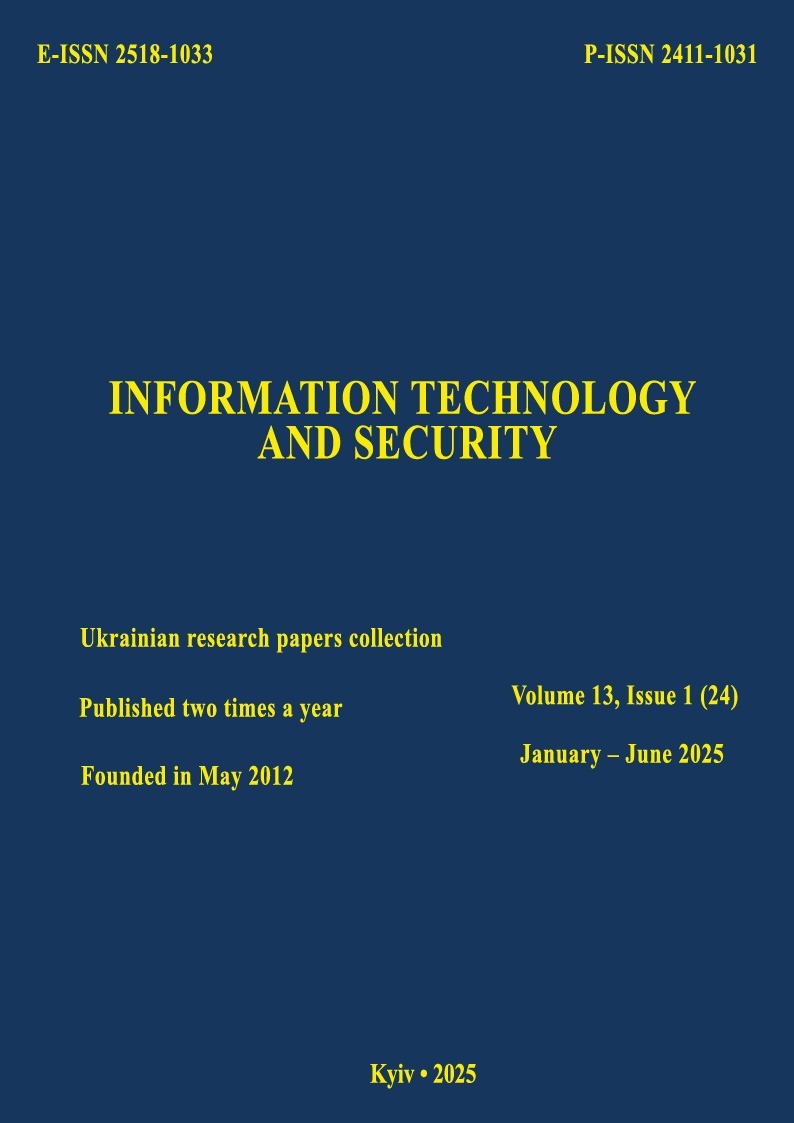Discrete models of geometric objects in parallel computing systems
DOI:
https://doi.org/10.20535/2411-1031.2025.13.1.328901Keywords:
MPI, OpenMP, R -functions, boundary element, method “Marching cubes”, parallel calculations, functional representationAbstract
The usage of powerful computer systems defines computational experiments as novel and significant research methods enabling to solve complex. Taking into account the fact that raditional analytical methods for visualizing mathematical models are of a determinative nature, there is still a need to apply modern mathematical theories which in their turn will enable to expand the possibilities of applied mathematical research. The object of the research is the process of developing functional design of complex geometric models. The subject of the research is the usage of parallel methods for constructing the surfaces of discrete models of some geometric objects. The methods of the research are: application of the apparatus of analytical geometry, mathematical analysis, the theory of R-functions, parallel architecture and numerical methods. The purpose of the research is to solve current scientific and technical problems, in particular to increase the efficiency in the design of the programme for building discrete models, which can be implemented in the finite element analysis of complex technical systems by means of using parallel architecture. The following tasks were set to achieve the goal: analysis and review of currently known methods and approaches related to the construction of discrete models in complex computing systems. Development of the appropriate method and visualization of mathematical models based on the functional approach. Modification of the "Marching Cubes" method. Implementation in parallel architectures resorting to modern technologies and programming libraries, such as OpenMP and MPI, and conducting test experimental calculations that prove the efficiency of the proposed algorithm. Considering the importance of geometric model accuracy for the safety of complex technical systems, the application of parallel methods for building discrete models can significantly impact the reliability and safety in the development and testing of high-tech products, particularly in fields such as rocket engineering. In the process of creating models used for designing rocket systems and other advanced technologies, it is crucial to achieve high precision, computational speed, and reliability of results. The developed parallel computation methods help reduce the risk of errors and optimize the design processes, which is vital for ensuring safety in this critical area.
References
M. Song, X. Zhang, and M. Lind, “Automatic identification of maintenance significant items in reliability centered maintenance analysis by using functional modeling and reasoning”, Computers & Industrial Engineering, vol. 182, pp. 1-19, 2023, doi: https://doi.org/10.1016/j.cie.2023.109409.
L. Amorim, T. Goveia, R. Mesquita, and I.J. Baratta, “GPU Finite Element Method Computation Strategy Without Mesh Coloring”, Optoelectronics and Electromagnetic Applications, vol. 19, no. 2, pp. 252-264, 2020, doi: https://doi.org/10.1590/217910742020v19i2851.
O. Hniezdovskyi, O. Kudin, Y. Belokon, D. Kruglyak, and S. Ilin, “Designing an objectoriented architecture for the finite element simulation of structural elements”, EasternEuropean Journal of Enterprise Technologies, vol. 6, no. 2 (120), pp. 78-84, 2022, doi: https://doi.org/10.15587/1729-4061.2022.268018.
Mathematical and computer modelling of engineering systems: Collective monograph, V.S. Hudramovich, Eds. Riga, Latvia: Baltija Publishing, 2020.
A. F. Bulat, V. I. Dyrda, S. M. Grebenyuk, and M. I. Klymenko, “Numerical Simulation of Viscoelastic Deformation of Rubber Shock Absorbers Based on the Exponential Law”, Strength of Materials, no. 54, iss. 5, pp. 776-784, 2022, doi: https://doi.org/10.1007/s11223022-00454-8.
C. Suchocki, and S. Jemiolo, “On Finite Element Implementation of Polyconvex Incompressible Hyperelasticity: Theory, Coding and Applications”, Int. J. of Computational Methods, vol. 17, no 8, pp 1-36, 2020, doi: https://doi.org/10.1142/S021987621950049X.
A. Akoushideh, and A. Shahbahrami, “Performance Evaluation of Matrix-Matrix Multiplication using Parallel Programming Models on CPU Platforms”. PREPRINT (Vers. 1) available at Research Square, pp 1-23, 2022, doi: https://doi.org/10.21203/rs.3.rs-2135830/v1.
A. V. Kaliuzhniak, “Computation efficiency enhancement in distributed computer systems with the MPI library assistance”, Applied problems of mathematical modeling, vol. 6, no. 1, pp. 6673, 2023, doi: https://doi.org/10.32782/mathematical-modelling/2023-6-1-7.
Downloads
Published
How to Cite
Issue
Section
License
Copyright (c) 2025 Collection "Information Technology and Security"

This work is licensed under a Creative Commons Attribution 4.0 International License.
The authors that are published in this collection, agree to the following terms:
- The authors reserve the right to authorship of their work and pass the collection right of first publication this work is licensed under the Creative Commons Attribution License, which allows others to freely distribute the published work with the obligatory reference to the authors of the original work and the first publication of the work in this collection.
- The authors have the right to conclude an agreement on exclusive distribution of the work in the form in which it was published this anthology (for example, to place the work in a digital repository institution or to publish in the structure of the monograph), provided that references to the first publication of the work in this collection.
- Policy of the journal allows and encourages the placement of authors on the Internet (for example, in storage facilities or on personal web sites) the manuscript of the work, prior to the submission of the manuscript to the editor, and during its editorial processing, as it contributes to productive scientific discussion and positive effect on the efficiency and dynamics of citations of published work (see The Effect of Open Access).

